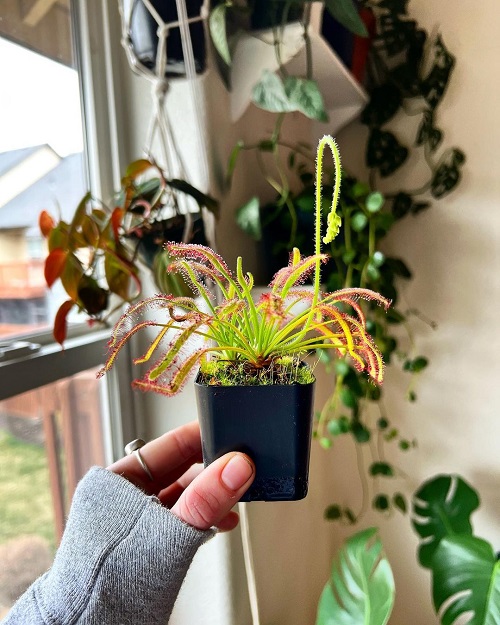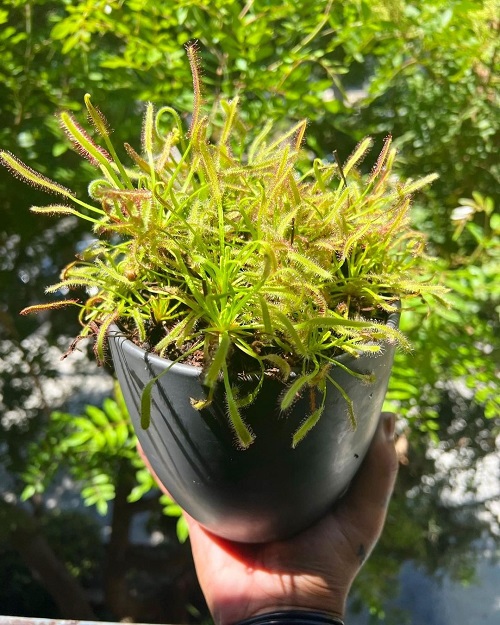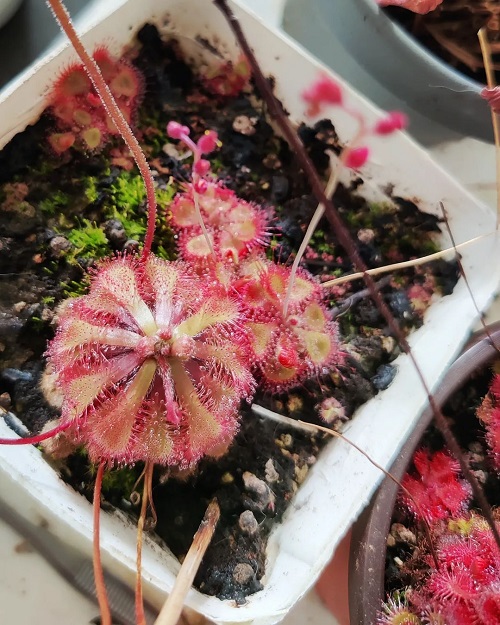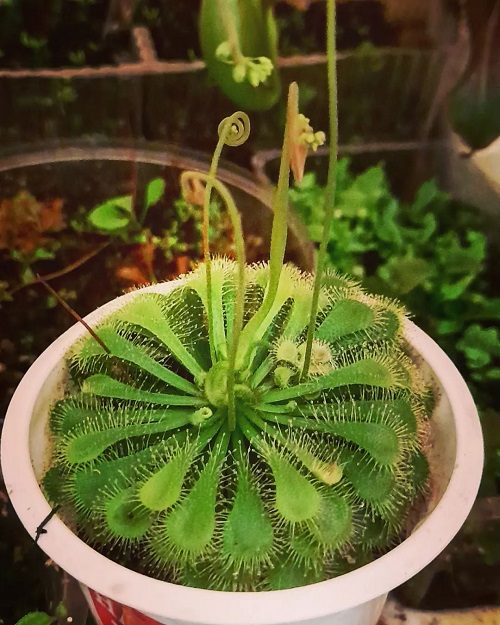Learn in detail about Sundew Plant Care Indoors in easy steps! It can be a cute addition to tabletops and shelves!
The Sundew Plant, also known as Drosera, is a unique and fascinating carnivorous plant that belongs to the genus Drosera. This guide will help you into growing it easily indoors!
Have a look at the best carnivorous plants here
Sundew Plant Information
Sundew Plants have the highest species diversity in Australia, where about half of all known sundew species are found. Other regions with a significant number of sundew species include Africa, North and South America, Europe, and Asia.
The genus Drosera comprises over 200 known species, with a wide range of shapes, sizes, and growth habits. Sundew Plants can be classified into three main groups based on leaf morphology: rosetted sundews, tuberous sundews, and climbing sundews. Rosetted sundews have a basal rosette of leaves, tuberous sundews grow from underground tubers, and climbing sundews have vining or scrambling growth habits.
The leaves of Sundew Plants are the most distinctive feature. They are typically covered in glandular hairs or tentacles, each of which secretes a sticky fluid or mucus. These tentacles have glandular structures at their tips that produce enzymes to aid in prey digestion. The sticky secretions help trap and immobilize small insects and other arthropods.
Check out Carnivorous Plants For Terrariums here
Propagating Sundew Plant

Indoor propagation of Sundew Plants can be accomplished through various methods, and growing them from seeds is the easiest.
- Sundew Plant seeds are very small, almost resembling fine dust or powder, so it is crucial to handle them with care to avoid losing them.
- Prepare pots with carnivorous potting mix, and ently scatter the seeds on the surface of the soil and lightly dust them with a thin layer of sand. The sand helps keep the seeds in place until they sprout and assists the delicate roots in breaking through the soil.
- Mist the seeds with water and cover the container with a clear plastic sheet or place it in a clear storage tote with a lid to maintain humidity.
- Provide the seeds with 5-6 hours of morning sunlight per day.
- Within two to four weeks, the seeds should start to sprout, and the seedlings will soon resemble miniature versions of the mature plants.
Some other methods to grow these plants are:
- Leaf Cuttings: Take a healthy leaf from the parent plant and place it on a moist growing medium, such as a mix of sphagnum moss and perlite. New plantlets will emerge from the leaf’s base and can be potted once they develop roots.
- Division: Carefully separate the clumps of sundew plants into smaller sections, ensuring each division has roots attached. Replant the divisions in individual pots with suitable growing medium.
- Tissue Culture: A more advanced method, tissue culture involves taking small tissue samples from the parent sundew plant and growing them in a laboratory under controlled conditions. This method allows for mass propagation and is often used for rare or difficult-to-propagate sundew species.
Check Best Carnivorous Houseplants here
Requirements for Growing Sundew Plant Indoors

Location
Sundew plants generally require bright, indirect sunlight or a few hours of direct morning sunlight each day. They are native to habitats with full sunlight exposure, providing them with adequate light is crucial for their health and growth.
Place your Sundew plants near a south or west-facing window. Avoid exposing them to intense midday sunlight, which may scorch the leaves.
Soil
Sundews are carnivorous plants that obtain nutrients from insects they capture. They prefer nutrient-poor soil that is low in organic matter.
A common soil mix for sundews consists of a combination of sphagnum moss, peat moss, perlite, and sand. Avoid using regular potting soil or soil mixes that retain too much water. Go for a pre-mix carnivorous growing medium for best growth.
Water
Sundew plants are okay to grow in nutrient-poor environments, and tap water often contains minerals that can harm them. It is recommended to use distilled, RO, or rainwater for watering sundew plants.
Alternatively, you can collect and store tap water for a day to allow the chlorine and other chemicals to dissipate. Ensure that the soil remains moist but not waterlogged. Avoid allowing the soil to completely dry out between waterings.
Temperature and Humidity
Sundew plants generally prefer temperatures between 60°F (15°C) and 80°F (27°C). However, they can tolerate slightly cooler or warmer temperatures for short periods.
Sundews require high humidity levels to thrive. Aim for humidity levels between 50% to 70% or higher. If the air in your home is dry, you can increase humidity by using a humidifier, placing the plants on a tray filled with water and pebbles, or grouping them together to create a microclimate.
Follow 17 Ideas & Tips For Growing Carnivorous Plants In Containers here
Sundew Plant Care

Fertilizer
Fertilizing Sundew plants indoors is not always necessary since they obtain most of their nutrients from the insects they catch.
If you want to boost the growth of the Sundew plants, use a diluted, low-strength fertilizer specifically formulated for carnivorous plants or orchids. do it once in two to three months.
Avoid using regular houseplant fertilizers, as they can contain high levels of minerals that are harmful to sundews.
Pests and Diseases
Sundew plants can be susceptible to aphids, fungus gnats, and spider mites. To combat these pests, it is important to maintain good plant hygiene, increase humidity, regularly mist the leaves, and use appropriate treatments such as insecticidal soap, neem oil, or sticky traps.
Preventive measures like allowing the soil to dry slightly between waterings and ensuring proper drainage can also help in preventing various diseases in Sundew plants.


